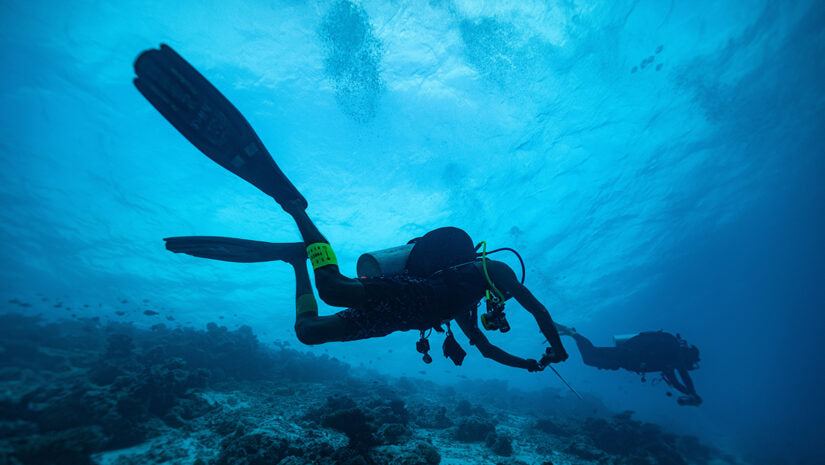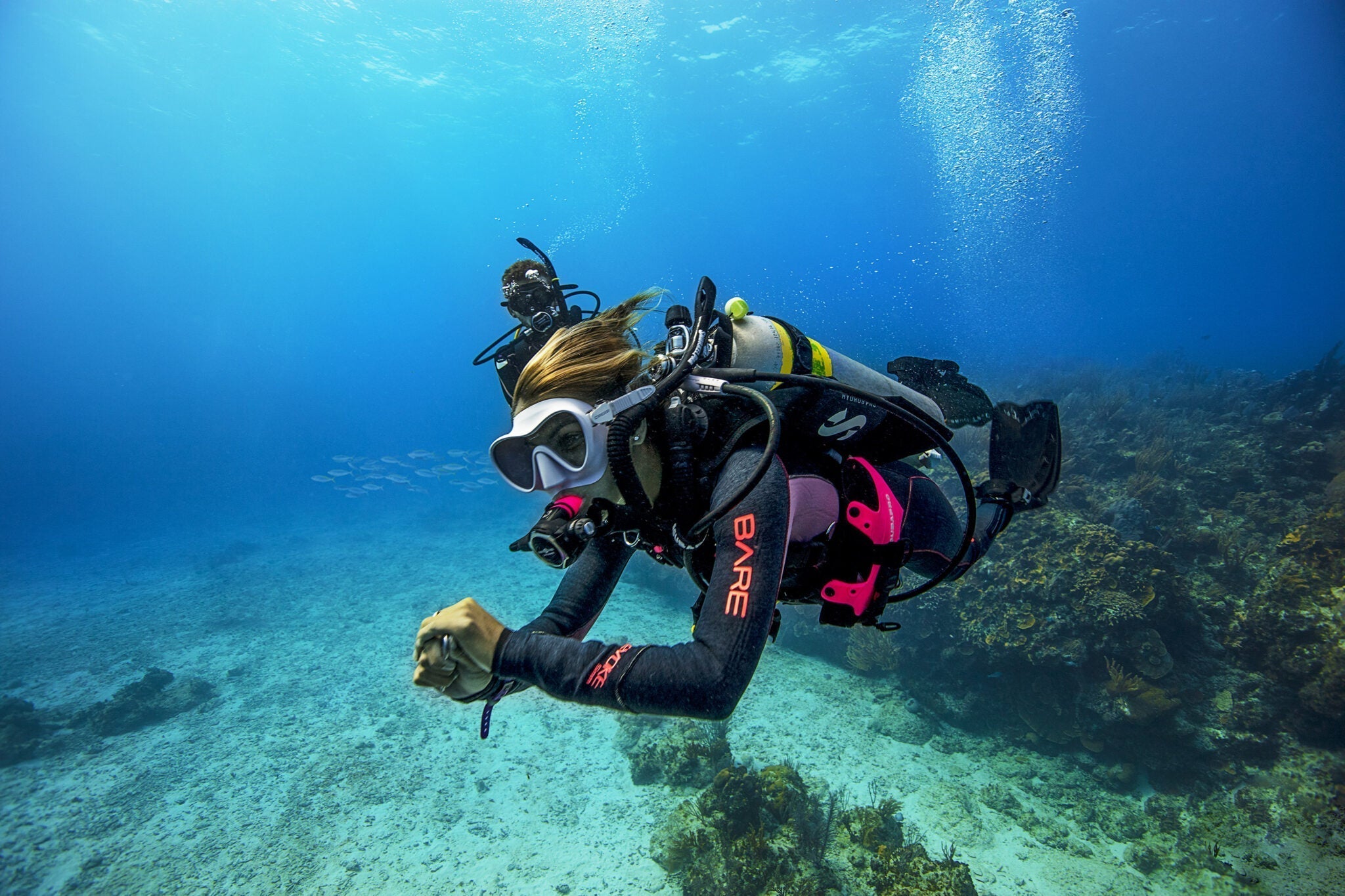Before diving with a handheld scuba tank, perform these 7 checks: 1) Inspect the tank for dents/cracks (even small damage can be hazardous); 2) Confirm the pressure gauge reads 200-300 bar (standard range); 3) Check the O-ring for wear (prevents leaks); 4) Test the valve operation (should turn smoothly); 5) Verify the last hydrostatic test date (required every 5 years); 6) Ensure the regulator attaches securely (listen for hissing); 7) Submerge the tank in water to detect bubbles (indicates leaks). Always prioritize safety over convenience.
Check Tank Condition
Around 12% of scuba incidents involve equipment failure, and tanks with dents, deep scratches, or corrosion are particularly risky. The most critical areas to check are the cylindrical body, valve threads, and base ring, where stress fractures often develop.
Tanks are typically made of aluminum (3AA or 3AL) or steel (DOT-3AA), with aluminum being more prone to external damage due to its softer material. A dent deeper than 0.5 mm or a scratch that catches your fingernail means the tank should be inspected by a professional before use. Rust is another red flag—surface rust can often be cleaned, but pitting corrosion (holes deeper than 1 mm) can weaken the tank’s structural integrity.
Hydrostatic testing is mandatory every 5 years (or 3 in some regions), but visual inspections should happen before every dive. A common mistake is ignoring small dents near the tank’s shoulder—this area handles high stress, and even minor damage can worsen over time. If you find cracks, bulges, or severe corrosion, retire the tank immediately—repairs are not allowed on pressurized cylinders.
Common Tank Defects & Risks
| Defect Type | Acceptable Limit | Action Required |
|---|---|---|
| Surface scratches | No depth (nail doesn’t catch) | Clean & monitor |
| Dents | < 0.5 mm deep, < 25 mm diameter | Professional inspection |
| Pitting corrosion | < 1 mm deep, < 10% of surface | Sand & polish if minor |
| Cracks | Zero tolerance | Tank must be retired |
| Bulges/swelling | None allowed | Immediate retirement |
A single compromised tank can lose 50-100% of its air in seconds if the valve or seam fails. Always err on the side of caution—a $200 inspection is cheaper than an emergency ascent.
For divers in saltwater environments, rinsing the tank with fresh water after every dive reduces corrosion risk by up to 70%.
A well-maintained scuba tank lasts 20+ years, but neglect can shorten its lifespan to under 5 years. If your tank is older than 15 years, increase inspection frequency to every 2 years, even if hydrostatic tests are up to date. Remember: your life depends on this metal cylinder—treat it with respect.
Test Pressure Levels
A handheld scuba tank should hold between 200 and 300 bar (2,900–4,350 psi) when fully charged. If it’s below 150 bar (2,175 psi), you risk running out of air faster than planned, especially in deeper dives where consumption increases by 30-50% due to pressure. Overfilling beyond 330 bar (4,785 psi) can stress the tank’s structure, increasing the chance of failure.
Most modern tanks have a burst disc that ruptures at around 400 bar (5,800 psi) to prevent explosions, but relying on this as a safety net is reckless. Always use a high-quality pressure gauge—cheap ones can be off by ±10%, meaning a reading of 200 bar could actually be 180 or 220 bar. Digital gauges tend to be more accurate, with an error margin of just ±1-2%.
A tank filled to 300 bar at 25°C (77°F) will drop to 285 bar at 10°C (50°F). If you’re diving in cold water, account for this 5-7% loss when planning your air supply. Conversely, leaving a tank in direct sunlight can spike pressure by 8-10%, which is why you should never store tanks in hot cars or near heaters.
If your tank consistently loses more than 10 bar (145 psi) per week when stored, there’s likely a leak. The most common culprits are faulty valves (60% of leaks) or damaged O-rings (30%). A slow leak might seem harmless, but over a month, it can drain 40-50% of your tank’s air, leaving you with an unsafe reserve.
If you’re renting tanks, ask when they were last hydrostatically tested (required every 5 years). A poorly maintained tank can lose 5-10% of its pressure rating over time, meaning a 300-bar tank might only hold 270 bar after years of use.
Always check the gauge yourself—15% of dive accidents involve divers misjudging their air supply. A 5-second pressure check could be the difference between a smooth dive and an emergency ascent.

Inspect O-Ring & Valve
Over 40% of tank failures originate from faulty O-rings or valves, often leading to rapid air loss at depth. The main O-ring (a 2-3mm thick rubber seal) sits between the tank valve and regulator, enduring 300+ bar of pressure with every dive. If it's cracked, flattened, or missing chunks, it can fail catastrophically—a damaged O-ring at 30m (100ft) might dump 80% of your air in 90 seconds.
A healthy O-ring should rebound when stretched slightly—if it stays deformed, replace it immediately (cost: $1-3). Look for micro-cracks under bright light; even hairline fractures expand under pressure. Silicone-based lubricant can extend an O-ring's life from 50 dives to 100+, but petroleum-based products degrade rubber 3x faster.
Turn it fully open and closed 3-4 times—movement should be smooth, requiring less than 2kg of force. Stiffness indicates internal corrosion, while looseness suggests worn threads. Brass valves (common in steel tanks) last 8-10 years, while chrome-plated valves (aluminum tanks) degrade faster in saltwater, needing replacement every 5-7 years.
Leak-test the assembled system: One bubble every 3-5 seconds signals a minor leak (losing ~10 bar/hour), while a steady stream means immediate repair. Surprisingly, 60% of leaks occur during the first 5 minutes after pressurization—wait before testing.
For divers in tropical climates, O-rings degrade 30% faster due to UV exposure. Store them in dark, cool places when not in use. Always carry 2-3 spare O-rings (standard sizes: 011 or 112); they weigh <5g but prevent 90% of valve-related failures.
Pro tip: After saltwater dives, rinse valves with fresh water for 30 seconds—this reduces corrosion by 70%. If your valve has a dynamic seal (moving parts), apply food-grade grease every 20 dives. Never force a stuck valve—exceeding 5Nm of torque can snap the stem.
Remember: A 500 in lost air or worse—your safety. Spend 2 minutes checking these parts; it's the cheapest insurance policy in diving
Verify Hydrostatic Date
Hydrostatic testing is a non-negotiable safety check required every 5 years (3 years in some countries) to confirm your tank can still handle extreme pressure. A tank that fails this test has a 12% higher chance of rupturing at depth, where a single failure can empty your air supply in under 30 seconds.
The test itself involves filling the tank to 167% of its working pressure (e.g., 500 bar for a 300-bar tank) while submerged in water. Technicians measure expansion—if the tank stretches more than 10%, it’s unsafe. Aluminum tanks typically last 20-25 years with proper testing, while steel tanks can go 30+ years, but only if they pass every hydro. The date is stamped near the tank’s neck (e.g., "06/24" means June 2024 was its last test).
Expired hydro tests are the 1 reason tanks get rejected at dive shops. A tank just 1 month past its 5-year deadline can’t legally be filled in most countries. Some regions require an additional visual inspection (VIP) every 2.5 years, checking for internal corrosion that hydrostatic tests might miss.
Tanks older than 15 years face stricter scrutiny. They often need eddy current testing to detect microscopic cracks, adding $50-100 to the cost. If a tank fails hydro, it’s usually due to corrosion (70% of failures) or dent damage (25%). Only 5% of tanks fail from material fatigue, but when they do, it’s often catastrophic.
Hydro Test Failure Rates by Tank Age
| Tank Age | Failure Rate | Most Common Issue |
|---|---|---|
| 0-5 years | 2% | Manufacturing defects |
| 6-10 years | 8% | Valve thread corrosion |
| 11-15 years | 15% | Base ring pitting |
| 16-20 years | 22% | Stress fractures |
| 20+ years | 35% | Metal fatigue |
Rental tank red flag: 1 in 5 dive operators admit to "flexing" hydro dates by a few months. Always check stamps yourself—a faded or repainted stamp could mean tampering. Tanks used in saltwater need 2x more frequent visual inspections due to accelerated corrosion.
Pro tip: Mark your calendar 6 months before expiry—testing centers get booked up. A tank that sits unused for 2+ years still needs testing; pressure cycles matter more than dive frequency. And never buy a used tank without verifying its hydro status—expired tanks lose 80% of their resale value.
Bottom line: That tiny stamped date is your guarantee the metal won’t fail when you’re 30m underwater. Treat it like your oxygen—because it is.
Look for Leaks
Industry data shows 1 in 8 dive emergencies stem from undetected equipment leaks, with 65% of these cases occurring in the first 10 minutes of submersion. The most dangerous leaks happen at the regulator first stage, where 300+ bar of pressure can empty a full tank in under 2 minutes if a seal fails completely.
Start your leak check with a soapy water test—mix 1 part dish soap with 5 parts water and apply to all connections. Even a slow leak (1 bubble every 5 seconds) means losing 15-20 bar per hour, which could cut your dive short unexpectedly. Pay special attention to the valve stem and O-ring areas, where 70% of leaks originate. For context, a dime-sized O-ring flaw at 30m depth can release air at 25 liters per minute—that's your entire breathing supply gone in 90 seconds.
A hissing sound indicates a major leak (losing 50+ bar/minute), while silent micro-leaks are trickier to detect. Use an ultrasonic leak detector if available—these $150 devices can find leaks 10x smaller than human ears can hear. Temperature affects leak rates too; a system that holds pressure at 20°C might leak 30% faster in 10°C water due to metal contraction.
Leak Severity Guide
| Leak Rate | Air Loss | Emergency Level |
|---|---|---|
| 1 bubble/10 sec | 5 bar/hour | Monitor |
| 1 bubble/5 sec | 15 bar/hour | Fix before diving |
| Continuous stream | 50+ bar/min | Immediate abort |
For rental gear, always perform a 2-minute pressure hold test: Note the gauge reading, wait 120 seconds, then check again. Any drop over 5 bar means trouble. Surprisingly, 40% of rental tanks show some leakage—don't assume they're perfect.
Saltwater divers face extra challenges—corrosion increases leak risks by 50% compared to freshwater use. Always rinse your regulator with fresh water for 45 seconds after saltwater exposure; this simple step prevents 80% of salt-induced leaks. Store tanks with 50-100 bar of air inside—this maintains positive pressure that keeps seals tight 3x longer than empty storage.
Remember: Spending 5 extra minutes on leak checks could prevent an emergency ascent—your safety is worth every second.





Leave a comment
All comments are moderated before being published.
This site is protected by hCaptcha and the hCaptcha Privacy Policy and Terms of Service apply.